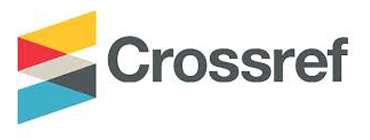TEACHERS’ PERCEPTIONS ON ADOPTING E-LEARNING DURING COVID-19 OUTBREAKS; ADVANTAGES, DISADVANTAGES, SUGGESTIONS
Abstract
Full Text:
PDFReferences
Abbasi, S., Ayoob, T., Malik, A., & Memon, S. I. (2020). Perceptions of Students Regarding E-learning During Covid-19 at a Private Medical College. Pakistan Journal of Medical Sciences, 36(COVID19-S4), 2–6. https://doi.org/10.12669/pjms.36.covid19-s4.2766
Al-Mubireek, S. (2019). E-learning in the English Classroom: Comparing Two E-Learning Platforms Impacting Preparatory Year Students’ Language Learning. Call-Ej, 20(2), 19–37. http://callej.org/journal/20-2/Al-Mubireek2019.pdf
Al Zumor, A. W. Q., Al Refaai, I. K., Bader Eddin, E. A., & Aziz Al-Rahman, F. H. (2013). EFL students’ Perceptions of A Blended Learning Environment: Advantages, Limitations and suggestions for Improvement. English Language Teaching, 6(10), 95–110. https://doi.org/10.5539/elt.v6n10p95
Barakati, D. P. (2013). Dampak Penggunaan Smartphone dalam Pembelajaran Bahasa Inggris (Persepsi Mahasiswa). Jurnal Elektronik Fakultas Sastra Universitas Sam Ratulangi, 1(1), 1–13. https://ejournal.unsrat.ac.id/index.php/jefs/article/view/1820
Darmalaksana, W., Hambali, R. Y. A., Masrur, A., & Muhlas. (2020). Analisis Pembelajaran Online Masa WFH Pandemic Covid-19 sebagai Tantangan Pemimpin Digital Abad 21. Karya Tulis Ilmiah (KTI) Masa Work From Home (WFH) Covid-19 UIN Sunan Gunung Djati Bandung Tahun 2020, 1(1), 1–12. http://digilib.uinsgd.ac.id/30434/
Dewi, S. V. (2016). Efektivitas Penggunaan Media Screencast O-Matic pada Mata Kuliah Kalkulus Integral terhadap Hasil Belajar Mahasiswa. Jurnal Penelitian Pendidikan Dan Pengajaran Matematika, 2(1), 61–66. http://jurnal.unsil.ac.id/index.php/jp3m/article/view/157
Dwiyogo, W. D., & Radjah, C. L. (2020). Effectiveness, Efficiency and Instruction Appeal of Blended Learning Model. International Journal of Online and Biomedical Engineering, 16(4), 91–108. https://doi.org/10.3991/ijoe.v16i04.13389
Endah Wulantina, S. M. (2019). Persepsi Peserta Didik terhadap Metode Blended Learning dengan Google Classroom. Jurnal Inovasi Matematika, 1(2), 110–121. https://doi.org/10.35438/inomatika.v1i2.156
Hartanto, W. (2016). Penggunaan E-Learning Sebagai Media Pembelajaran. Jurnal Pendidikan Ekonomi, 10(1), 1–18. https://jurnal.unej.ac.id/index.php/JPE/article/view/3438
Kartikawati, S., & Pratama, H. (2017). Pengaruh Penggunaan WhatsApp Messenger Sebagai Mobile Learning Terintegrasi Metode Group Investigation Terhadap Kemampuan Berpikir Kritis. Jupiter (Jurnal Pendidikan Teknik Elektro), 2(2), 33. https://doi.org/10.25273/jupiter.v2i2.1797
Khan, I. A. (2020). Electronic Learning Management System : Relevance , Challenges and Preparedness. Journal of Emerging Technologies and Innovative Research ((JETIR), 7(5), 471–480. https://d1wqtxts1xzle7.cloudfront.net/63286717/JETIR200507220200512-32400-1ynnf6.pdf?1589300548=&response-content-disposition=inline%3B+filename%3DElectronic_Learning_Management_System_Re.pdf&Expires=1594297267&Signature=cfutSdRoGOHnrWs3p1R-LwnHqsXoisi7D7
Kristiono, I. D., Dwiyogo, W. D., & Hariadi, I. (2019). Pembelajaran Ilmu Gizi Olahraga Berbasis Blended Learning pada Mahasiswa Pendidikan Jasmani, Kesehatan, dan Rekreasi. Jurnal Pendidikan: Teori, Penelitian, Dan Pengembangan, 4(2), 235–241. https://doi.org/http://dx.doi.org/10.17977/jptpp.v4i2.12004
Nedeva, V., & Dimova, E. (2010). Some Advantages of E-Learning in English Language Training. Trakia Journal of Sciences, 8(8), 21–28. http://www.uni-sz.bg
Novantara, P., & Muhammad, A. (2018). Implementasi E-Learning Berbasis Virtual Class dengan Menggunakan Metode Synchronous Learning pada Pembelajaran di Universitas Kuningan. Jurnal Ilmiah Teknik Informatika, 4(1), 1–7. https://doi.org/https://doi.org/10.25134/buffer.v4i1.1290
Nurfalah, E. (2019). Optimalisasi E-Learning berbasis Virtual Class dengan Google Classroom sebagai Media Pembelajaran Fisika. Physics Education Research Journal, 1(1), 46–55. https://doi.org/10.21580/perj.2019.1.1.3977
Nurkhin, A., & Fachrurrozie. (2018). Pemanfaatan Media Sosial untuk Pembelajaran Akuntansi di Perguruan Tinggi; Studi Empiris di Universitas Negeri Semarang. Seminar Nasional Pendidikan, 1–10. https://publikasiilmiah.ums.ac.id/xmlui/handle/11617/10237
Sahu, P. (2020). Closure of Universities Due to Coronavirus Disease 2019 (COVID-19): Impact on Education and Mental Health of Students and Academic Staff. Cureus, 2019(4), 4–9. https://doi.org/10.7759/cureus.7541
Saputra, A. S., Kusumawardani, S. S., & Nugroho, E. (2017). Pengembangan Model Awal Sistem Evaluasi Penerimaan Pengguna E-Learning Janabadra. Prociding SENIATI 2017 (BOOK-1), 1(B3), 1–6. https://ejournal.itn.ac.id/index.php/seniati/article/view/1616
Shi, X. (2016). A comparative Study of E-Learning Platform in Reading and Translating Course for Engineering Students. International Journal of Emerging Technologies in Learning, 11(4), 120–125. https://doi.org/10.3991/ijet.v11i04.5551
Sohibun, S., & Ade, F. Y. (2017). Pengembangan Media Pembelajaran Berbasis Virtual Class Berbantuan Google Drive. Tadris: Jurnal Keguruan Dan Ilmu Tarbiyah, 2(2), 121. https://doi.org/10.24042/tadris.v2i2.2177
Suliswati, S., & Sari, I. W. (2019). Pembelajaran Fisika Berbantukan Media Sosial Facebook dan Dampaknya Terhadap Hasil Belajar Fisika. Jurnal Pendidikan Fisika, 7(1), 1–14. https://doi.org/http://dx.doi.org/10.24127/jpf.v7i1.1788
Sulisworo, D., Ishafit, & Firdausy, K. (2016). The Development of Mobile Learning Application Using Jigsaw Technique. International Journal of Interactive Mobile Technologies, 10(3), 11–16. https://doi.org/10.3991/ijim.v10i3.5268
Sulisworo, D., Nasir, R., & Maryani, I. (2016). Identification of Teachers’ Problems in Indonesia on Facing Global Community. International Journal of Research Studies in Education, 6(2), 81–90. https://doi.org/10.5861/ijrse.2016.1519
Talebian, S., Mohammadi, H. M., & Rezvanfar, A. (2014). Information and Communication Technology (ICT) in Higher Education: Advantages, Disadvantages, Conveniences and Limitations of Applying E-learning to Agricultural Students in Iran. Procedia - Social and Behavioral Sciences, 152, 300–305. https://doi.org/10.1016/j.sbspro.2014.09.199
Valentina, A., & Abaidoo Nelly. (2015). The Role of E-Learning, Advantages and Disadvantages of Its Adoption Inhigher Education. International Journal of Instructional Technology and Distance Learning, 12(1), 29–42. http://itdl.org/Journal/Jan_15/Jan15.pdf#page=7
Verawardina, U., Asnur, L., Lubis, A. L., Hendriyani, Y., Ramadhani, D., Dewi, I. P., Darni, R., Betri, T. J., Susanti, W., & Sriwahyuni, T. (2020). Reviewing online learning facing the Covid-19 outbreak. Talent Development and Excellence, 12(SpecialIssue3), 385–392. http://www.iratde.com/index.php/jtde/article/view/281
Wahyuni, F. A. (2016). Blended Learning : Dua Metode ( Synchronous and Asynchronous ) Untuk Matakuliah Writing Materi Argumentative Essay. Journal2.Um.Ac.Id/Index.Php/Jinotep/Article/Download/2379/1431, 3,(No 2 P. 137), 137–143. https://doi.org/http://dx.doi.org/10.17977/um031v3i22017p137
Wijaya, M. H., Sarosa, M., & Tolle, H. (2018). Rancang Bangun Chatbot Pembelajaran Java pada Google Classroom dan Facebook Messenger. Jurnal Teknologi Informasi Dan Ilmu Komputer, 5(3), 287. https://doi.org/10.25126/jtiik.201853837
Yusuf, B. N., & Ahmad Jihan. (2020). Are We Prepared Enough? a Case Study of Challenges in Online Learning in a Private Higher Learning Institution During the Covid-19 Outbreaks. Advances in Social Sciences Research Journal, 7(5), 205–212. https://doi.org/10.14738/assrj.75.8211
Zhou, L., Wu, S., Zhou, M., & Li, F. (2020). 'School’s Out, But Class’ On’, The Largest Online Education in the World Today: Taking China’s Practical Exploration During The COVID-19 Epidemic Prevention and Control As an Example. SSRN Electronic Journal, 4(2), 501–519. https://doi.org/10.2139/ssrn.3555520
DOI: http://dx.doi.org/10.30829/tar.v27i2.738
Refbacks
- There are currently no refbacks.

Jurnal Tarbiyah by UIN Sumatera Utara Medan is licensed under a Creative Commons Attribution-NonCommercial-ShareAlike 4.0 International License.
Based on a work at http://jurnaltarbiyah.uinsu.ac.id/index.php/tarbiyah.
Permissions beyond the scope of this license may be available at http://jurnaltarbiyah.uinsu.ac.id/index.php/tarbiyah/about/submissions#copyrightNotice.
















